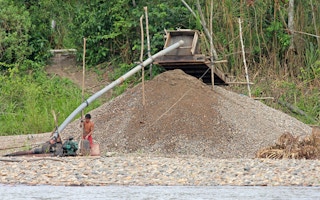The natural wealth of South America’s tropical forests is at growing risk from demand for its minerals − and specifically its gold.
Researchers says that a veritable global gold rush has led to a significant increase of deforestation in the region’s forests, and is having a growing environmental impact on some of the most biologically important areas in the tropics.
The researchers say the increased mining pressure is caused by rising demand and greater financial insecurity. In 2013, world gold production was more than 10 per cent greater than in 2000, and the price of the metal had increased almost fivefold.
The team, from the University of Puerto Rico, have published their findings in the journal Environmental Research Letters. They show that around 90 per cent of the deforestation occurred in just four areas, and that much of it happened close to conservation areas.
Increased mining
Between 2001 and 2013, around 1,680 square kilometres (650 square miles) of tropical moist forest lost in South America as a result of gold mining, the study says. The mining increased from around 377 to 1,303 sq km between 2007’s global economic crisis and 2013.
The study’s lead author, environmental scientist Nora L Álvarez-Berríos, said the loss of forest from mining was less than deforestation caused by other land uses, such as agriculture or ranching, but it was happening in some of the most biologically-diverse regions in the tropics.
She said: “For example, in the Madre de Dios Region in Peru, one hectare of forest can hold up to 300 species of trees.”
The study says a combination of growing personal consumption and uncertainty in global financial markets has driven up global gold production from around 2,445 tonnes in 2000 to about 2,770 in 2013. At the same time, the price of gold rose from US $250 to $1,300 an ounce (28 grammes).
This has stimulated new gold mining activity around the world and has made it possible in previously unprofitable areas, including deposits beneath tropical forests.
“
It is important also to encourage more responsible ways of extracting gold by helping miners to extract in a more efficient way to reduce deeper encroachment into the forests
Prof Nora L Álvarez-Berríos, author, University of Puerto Rico
The researchers say this spread can not only lead to extensive forest loss but result as well in serious environmental impacts, caused by the removal of vegetation, the building of roads and railways for access, and the creation of informal settlements.
Long-term impacts, they say, can include the failure of vegetation to regrow, changes in rainfall patterns, permanent loss of biodiversity, and the release of carbon dioxide to the atmosphere.
They sought to quantify the impacts of gold mines in tropical forests by creating a geographical database that highlighted the location of newly-developed mines between 2000 and 2013. This was then cross-referenced with annual land cover maps showing the change in forest cover over the same period.
Forest loss
The study examined the tropical and subtropical forest biome − one of the world’s major physical communities, classified according to its predominant vegetation − below 1,000 metres in Colombia, Venezuela, Guyana, Suriname, French Guiana, Brazil, Ecuador, Peru and Bolivia.
The results showed that, over the 13-year study period, 89 per cent of forest loss occurred in just four ecoregions of South America: the Guianan, southwest Amazon, Tapajós-Xingú, and Magdalena Valley-Urabá.
There was little deforestation inside strict protection areas, but around a third of the total occurred within a 10km buffer zone around them, leaving the zones exposed to the harmful impacts of the chemical pollutants dispersed from mines.
Professor Álvarez-Berríos said consumers’ awareness needs to be raised about the environmental and social impacts of buying or investing in gold.
She said: “It is important also to encourage more responsible ways of extracting gold by helping miners to extract in a more efficient way to reduce deeper encroachment into the forests.”










